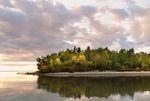Canadian Wilderness Stewardship Program (2021-2022)
←
→
Page content transcription
If your browser does not render page correctly, please read the page content below
Canadian Wilderness Stewardship Program (2021-2022)
Empowering Youth to Be Leaders in Conservation
The Canadian Wilderness Stewardship Program is a Canadian Parks and Wilderness Society (CPAWS)
initiative funded by the Canada Service Corps. Canadian youth between 18-30 years old will connect with
Canada’s wild spaces through guided expeditions of regional ecosystems and by performing community
service projects.
Program Goals
• To enable participants to experience the benefits of performing meaningful volunteer community
service in their regions
• To build participants’ confidence, leadership ability, and critical thinking skills
• To empower participants to become ambassadors for regional wild spaces within their communities
and create a culture of conservation engagement
Program Activities
As part of the Canadian Wilderness Stewardship Program, youth will participate in a wilderness expedition
of a regional watershed or other area of conservation value and will be asked to design and execute, with
the support of CPAWS program coordinators, a volunteer community service project. Projects will aim to
educate participants’ local communities on the importance of their regional watersheds. The final event of
the program is a summit where participants from across Canada come together to share their experiences
and gain skills related to career building, civic duty, and community service.
Program Regions
CPAWS, along with registered wilderness guides and invited experts, will lead program participants on
expeditions in New Brunswick, western Québec, Manitoba, and southern Alberta.1 These wilderness
experiences will educate participants about the ecological, economic, social, and cultural importance of
these regions, providing tools and opportunities to conserve these important landscapes.
1
The final expedition sites will be determined by CPAWS program staff, taking into account restrictions that may be
imposed due to the COVID-19 pandemic.
1Bay of Fundy, New Brunswick
Expedition Dates: August 21-22
The Bay of Fundy, located between New Brunswick and
Nova Scotia in the Atlantic Ocean, has the world’s highest
tides and an abundance of wildlife. Over 12 species of whales
are drawn to the Bay’s rich upwelling zones, including
humpback, fin, and the endangered North Atlantic right
whale. Millions of shorebirds flock to the salt marshes and
mudflats on the Bay of Fundy shores each year during their
long migrations to fatten up on mud shrimp. This magnificent
wild expanse supports numerous fishing communities and
tourism businesses. To bring fairness to the use of the Bay,
a network of Marine Protected Areas (MPAs) needs to
conserve the most ecologically significant areas, with a
combination of larger sites in the outer bay and smaller Photo: Erinn Sharpe
coastal sites closer inland. These would include areas where
whales congregate, as well as important bird areas, rich mudflats, corals and reefs, and some estuaries.
Noire River, Québec
Expedition Dates: September 17-19
The Noire is a 238 km long river in the Outaouais region
of Southwestern Québec. The watershed is home to a 55
hectares of rare forest composed of black ash and American
elm. The Noire River is named for the very dark colour of its
water. The river is important to the Outaouais’ conservation
landscape because it, along with its sister rivers the
Coulonge and Dumoine, creates an ecological corridor
linking the Ottawa River to the boreal forest. This connection
is critical to allow species to migrate north to adapt to climate
change. These rivers shelter rich biodiversity consisting of
many rare or endangered species, including both animals and
plants. Photo: CPAWS
2Fisher Bay, Manitoba
Expedition Dates: TBD
The land surrounding Fisher Bay is remarkably
undisturbed despite its relatively short distance from
urban, industrial, and agricultural development. Every
shoreline provides glimpses of the thriving biological
diversity found as Fisher Bay. Expansive beaches line
both the mainland and islands. Fresh tracks are left in
the sand by wolves, moose, foxes, and bears passing
in and out of old-growth forests. Water birds continually
wing by, traveling from nesting colonies to feeding
grounds, while songbirds bring the forest canopy to life
with their calls. The lands and waters offer habitat for
rare, threatened, and endangered species, including
the little brown bat, piping plover, golden-winged
warbler, shortjaw cisco, swamp pink, and round-leaved Photo: Ron Thiessen
bog orchid. Our partners in Fisher River Cree Nation play a strong role in promoting stewardship and
conservation of the region's natural landscapes, and traditional knowledge will be prominent in many of
the learning opportunities.
Castle Wildland Provincial Park, Southern Alberta
Expedition Dates: August 23-25
CPAWS Southern Alberta will lead a three-day
backpacking expedition into the majestic Castle Wildland
Provincial Park, located in the Rockies of southwestern
Alberta. This area is home to over 120 provincially rare
plant species and 59 species of mammals - second only
to Waterton National Park for species richness
(i.e. number of species) in the province - and is a water
tower for much of southern Alberta, providing one-third of
all water in the Oldman Watershed. The park is a critical
connection for grizzly bears, and other wide-ranging
mammals, from Waterton-Glacier National Peace Park to
other protected areas in Canada. Furthermore, it has Photo: Barbara Bronson
profound cultural and sacred value to the Nitsitapii, Piikani
(Peigan), Siksika, Kainaiwa (Blood), and Blackfeet First Nations, as well as the Nakoda (Stoney)
and K’tunaxa First Nations. By immersing participants in the wilderness setting of Castle, they will
experience and come to understand how crucial it is to the state and health of the Crown of the Continent
Ecosystem and the greater Rocky Mountain ecosystems.
3You can also read





















































